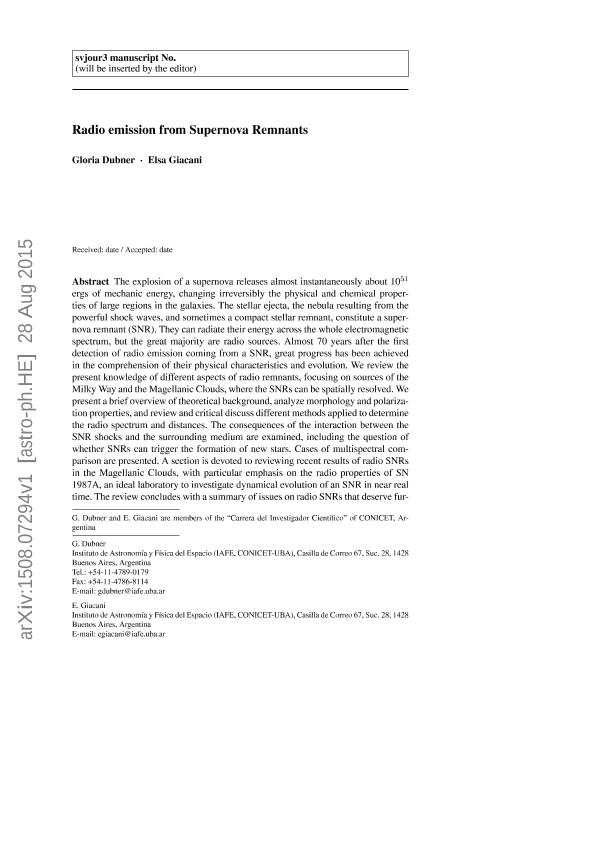Mostrar el registro sencillo del ítem
dc.contributor.author
Dubner, Gloria Mabel

dc.contributor.author
Giacani, Elsa Beatriz

dc.date.available
2017-06-08T21:42:14Z
dc.date.issued
2015-09-16
dc.identifier.citation
Dubner, Gloria Mabel; Giacani, Elsa Beatriz; Radio emission from Supernova Remnants; Springer; Astronomy And Astrophysics Review; 23; 1; 16-9-2015; 3-52
dc.identifier.issn
0935-4956
dc.identifier.uri
http://hdl.handle.net/11336/17856
dc.description.abstract
The explosion of a supernova releases almost instantaneously about 10^51ergs of mechanic energy, changing irreversibly the physical and chemical proper- ties of large regions in the galaxies. The stellar ejecta, the nebula resulting from the powerful shock waves, and sometimes a compact stellar remnant, constitute a super- nova remnant (SNR). They can radiate their energy across the whole electromagnetic spectrum, but the great majority are radio sources. Almost 70 years after the first detection of radio emission coming from a SNR, great progress has been achieved in the comprehension of their physical characteristics and evolution. We review the present knowledge of different aspects of radio remnants, focusing on sources of the Milky Way and the Magellanic Clouds, where the SNRs can be spatially resolved. We present a brief overview of theoretical background, analyze morphology and polariza- tion properties, and review and critical discuss different methods applied to determine the radio spectrum and distances. The consequences of the interaction between the SNR shocks and the surrounding medium are examined, including the question of whether SNRs can trigger the formation of new stars. Cases of multispectral com- parison are presented. A section is devoted to reviewing recent results of radio SNRs in the Magellanic Clouds, with particular emphasis on the radio properties of SN 1987A, an ideal laboratory to investigate dynamical evolution of an SNR in near real time. The review concludes with a summary of issues on radio SNRs that deserve further study, and analyzing the prospects for future research with the latest generation radio telescopes.
dc.format
application/pdf
dc.language.iso
eng
dc.publisher
Springer

dc.rights
info:eu-repo/semantics/openAccess
dc.rights.uri
https://creativecommons.org/licenses/by-nc-sa/2.5/ar/
dc.subject
Supernova Remnants
dc.subject
Radio
dc.subject.classification
Astronomía

dc.subject.classification
Ciencias Físicas

dc.subject.classification
CIENCIAS NATURALES Y EXACTAS

dc.title
Radio emission from Supernova Remnants
dc.type
info:eu-repo/semantics/article
dc.type
info:ar-repo/semantics/artículo
dc.type
info:eu-repo/semantics/publishedVersion
dc.date.updated
2017-06-06T14:48:05Z
dc.journal.volume
23
dc.journal.number
1
dc.journal.pagination
3-52
dc.journal.pais
Alemania

dc.journal.ciudad
Berlin
dc.description.fil
Fil: Dubner, Gloria Mabel. Consejo Nacional de Investigaciónes Científicas y Técnicas. Oficina de Coordinación Administrativa Ciudad Universitaria. Instituto de Astronomía y Física del Espacio. - Universidad de Buenos Aires. Facultad de Ciencias Exactas y Naturales. Instituto de Astronomía y Física del Espacio; Argentina
dc.description.fil
Fil: Giacani, Elsa Beatriz. Consejo Nacional de Investigaciónes Científicas y Técnicas. Oficina de Coordinación Administrativa Ciudad Universitaria. Instituto de Astronomía y Física del Espacio. - Universidad de Buenos Aires. Facultad de Ciencias Exactas y Naturales. Instituto de Astronomía y Física del Espacio; Argentina
dc.journal.title
Astronomy And Astrophysics Review

dc.relation.alternativeid
info:eu-repo/semantics/altIdentifier/url/http://dx.doi.org/ 10.1007/s00159-015-0083-5
dc.relation.alternativeid
info:eu-repo/semantics/altIdentifier/arxiv/https://arxiv.org/abs/1508.07294
dc.relation.alternativeid
info:eu-repo/semantics/altIdentifier/url/https://link.springer.com/article/10.1007/s00159-015-0083-5
Archivos asociados
